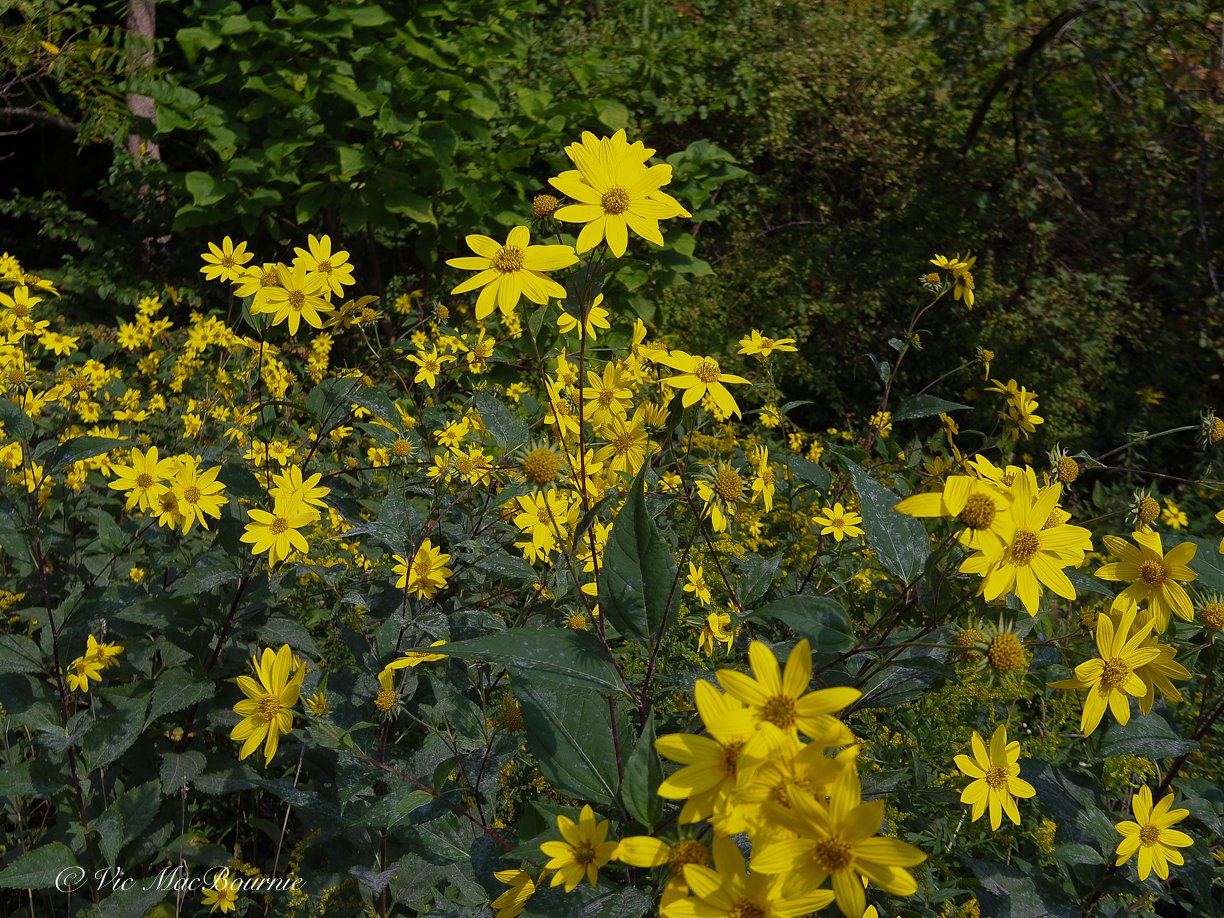Plant Native Sunflowers for the bees, butterflies and the birds
A grouping of Woodland sunflowers in their prime light up the edge of a forested area. The sunflowers are a magnet for native bees and butterflies and their hollow stems provide winter nesting habitat for native bees.
Woodland sunflowers are native to Ontario and parts of the United States
It’s not just good looks that make our native sunflowers a must for the woodland garden. Their popularity among butterflies, native bees, birds and other insects makes these tall shrubby plants a popular choice for wildlife gardeners.
In our garden, the multi-flowering, bright yellow Woodland sunflowers (Helianthus divaricatus) grow at the back of the property alongside other meadow-style plants such as Black-eyed susans, New England and Wood Asters. They seem happy to grow beneath our crabapples where they receive mostly dappled afternoon and late afternoon sun.
If you are looking for more information on growing native flowers, you might be interested in reading my comprehensive article: Why we should use native plants in our gardens.
The Woodland sunflower is native to the eastern United States and Canada and can be found along roadsides and on the edge of woodlands and forested areas.
A large grouping of Woodland Sunflowers looking their best backlit against a dark background.
Hardy in zones 3 to 7, they work beautifully planted along woodland edges together with Black-Eyed Susan, Scarlett and Spotted Bee-Balms, and goldenrods. They will thrive and spread quickly in full sun but also do well in partial shade.
Generally these prolific bloomers, that can grow up to 6-feet tall, can be found growing naturally in dry, open woodlands, making them perfect for our woodland gardens.
The tall stems support the 2-inch (5cm) yellow flowers that sport 8-15 petals and a darker yellow centre disk. The flowers bloom from early summer to fall. The self-seeding sunflowers spread by rhizomes accounting for the large colonies often seen growing along forest edges and roadsides.
Besides dividing the clumps every 3-4 years to control spread and maintain the plants’ vigour, these Sunflowers are generally low-maintenance with no pest or disease issues.
A single woodland sunflower growing in our garden. You can see the buds of more sunflowers preparing to bloom.
Our deer have no interest in the woodland sunflowers probably because of the plant’s tough stems and rough leaves that make them less desirable.
Even Walnut trees are no match for the woodland sunflowers.
Without a doubt, they are a favourite of bees and butterflies where they act as a host plant for more than 73 varieties of butterflies and moths as well as a number of other insects that depend on the plant.
In turn, the caterpillars and insects that use the sunflowers as host plants, attract birds that depend on the insects as a source of food.
The Painted Lady, silvery Checkerspot and Gorgone Checkerspot are just three butterflies that use native sunflowers as a host plant for their larvae.
Birds and small mammals can often be seen eating the seeds right off the fading flowers.
Our native sunflowers are also an important plant for native bees that use the plants’ hollow stems for nesting. It’s important not to cut down the plants after flowering to give native cavity nesting bees a safe, warm place to overwinter their larvae. Leave the long stems in place at least until late into spring.
More native sunflowers
• Pale-leaved Sunflower (Helianthus Stromosus) grows to just 4 feet, in sun to part sun conditions in average to dry sandy loam.
• Other native sunflowers include Giant Sunflower (Helianthus giganteus) that grows up to 10 feet in sun to partioal shade in sandy loam.
If you are on the lookout for high quality, non-GMO seed for the Pacific North West consider West Coast Seeds. The company, based in Vancouver BC says that “part of our mission to help repair the world, we place a high priority on education and community outreach. Our intent is to encourage sustainable, organic growing practices through knowledge and support. We believe in the principles of eating locally produced food whenever possible, sharing gardening wisdom, and teaching people how to grow from seed.”



